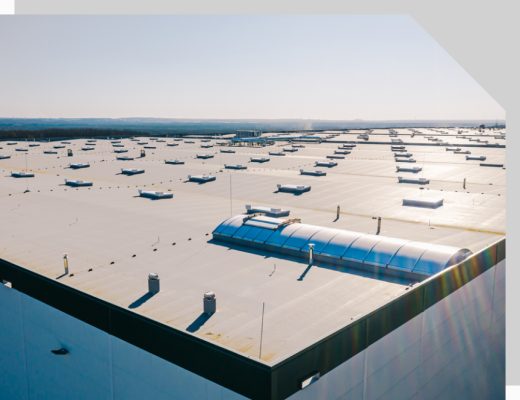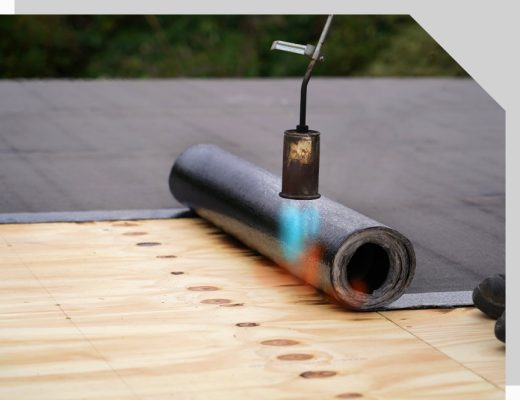Flat Roof Repair from Our Roofing Contractors
Flat roofs offer numerous benefits, such as cost-effectiveness and easy access, making them a popular choice for commercial and residential buildings alike. However, like any roofing system, flat roofs are susceptible to wear and tear over time. From roof leaks to ponding water, addressing flat roof repair issues promptly is crucial to preventing costly damage to the building’s interior and structure.
The skilled Edgewater roofing contractors at Thunder Bay Roofing explain the key aspects of flat roofing repair. If you need a roof inspection, contact our roofers today at 410-956-7663. Don’t avoid repairs and risk the possibility of an entire roof replacement.

Common Flat Roofing Issues
If you’re experiencing any of the following issues with your roof, contact Thunder Bay Roofing for an inspection:
- Pooling Water: Flat roofs are prone to water pooling, especially if the drainage system isn’t properly designed or if debris clogs the drains. Prolonged water pooling can lead to leaks and structural damage.
- Leakage: Leaks are a common problem with flat roofs. They can occur due to various reasons, such as damaged membranes, punctures, or improperly sealed seams. Regular inspections and prompt repairs are essential to prevent water damage and multiple leaks from occurring.
- Ponding Water: Similar to pooling, ponding water refers to the accumulation of water on the roof’s surface. It’s often caused by poor drainage, an inadequate slope, or a sagging roof structure. Ponding water can accelerate the deterioration of roofing materials.
- Damaged Roof Material: Flat roofing materials, such as built-up roofing (BUR), single-ply membranes, or modified bitumen, can deteriorate over time due to exposure to the elements. This deterioration can lead to cracks, tears, and other vulnerabilities that compromise the roof’s integrity.
- Flashing Issues: Flashing is crucial for sealing joints and transitions on a flat roof. Improper installation or deterioration of flashing materials can result in water infiltration. Regular maintenance and inspections are essential to address flashing issues promptly.
- Blistering: Blisters are bubbles that form on the surface of the roofing membrane, often due to trapped moisture or poor installation. Blisters can compromise the roof’s waterproofing capabilities and should be addressed to prevent further damage.
- Poor Roof Installation: A poorly installed flat roof is prone to various issues. It’s essential to hire experienced and qualified roofing professionals for the installation to ensure that the roof is properly sloped, sealed, and equipped with adequate drainage.
- Thermal Movement: Flat roofs are exposed to temperature fluctuations, leading to thermal expansion and contraction. This movement can cause stress on the roofing materials, potentially resulting in cracks, separations, or other issues.
How Does Roof Damage Occur?
Damage to flat roofs can occur due to various factors, and understanding these causes is crucial for proper maintenance and prevention. Here are some common ways in which damage can happen to flat roofs:
- Weathering: Exposure to the elements, including sunlight (UV radiation), rain, snow, and temperature fluctuations, can lead to the gradual degradation of roofing materials. Over time, this weathering can cause materials to weaken, crack, or lose their elasticity.
- Poor Installation: If a flat roof isn’t installed correctly, it’s more prone to damage. Issues such as improper slope, inadequate drainage, and insufficient sealing of seams or flashing can contribute to leaks, water pooling, and other problems.
- Accumulation of Debris: Leaves, branches, dirt, and other debris can accumulate on a flat roof, blocking drainage pathways and causing water pooling. This debris can trap moisture, promoting the growth of algae and fungi, which can contribute to material deterioration.
- Mechanical Damage: The installation or maintenance of equipment on the roof, such as HVAC units or satellite dishes, can lead to mechanical damage if not done carefully. Dropping tools or heavy objects on the roof can cause punctures, tears, or other structural issues.
- Aging: Like any building component, flat roofs have a finite lifespan. As roofing materials age, they become more susceptible to damage. Regular inspections and proactive maintenance become increasingly important as a roof approaches the end of its expected life.
- Storm Damage: Severe weather events, such as hailstorms or high winds, can cause immediate and noticeable damage to a flat roof. This may include punctures, tears, or displacement of roofing materials.

Professional Flat Roof Repairs
Patching and Sealing
Experienced roofing contractors can address minor cracks and tears in the roofing material by applying high-quality roofing patch compounds or sealants, effectively preventing further damage and leaks.
Blister Repair
Our skilled roofing professionals will carefully cut out the affected area, ensure thorough drying, and then apply roofing adhesive before laying down new roofing material, effectively restoring the roof’s integrity.
Ponding Water Solutions
The accumulation of water in low spots on the roof (ponding) is especially common. Expert roofing contractors can create tapered areas or install drains to direct water away from low spots, preventing ponding water issues and potential structural damage.
Fixing Flashing
Damaged or corroded flashing around roof protrusions. A roofing contractor can replace the compromised flashing, ensuring a secure and watertight seal around vents, chimneys, and edges to prevent water intrusion.
Flat Roof Repair Costs
The costs of flat roof repair will vary, but they typically range between $300 and $1,200 on average. Factors affecting your total cost of repairing a flat roof include:
- Size of the roof: Larger roofs will cost more to repair than smaller roofs.
- Type of damage: Minor roof repairs, like patching a small lea,k will be cheaper than major repairs like replacing a large section of the roof.
- Roof material: Different materials have different repair costs. For example, patching a built-up roof (BUR) is typically cheaper than patching a metal roof.
- Accessibility of the roof: If your roof is difficult to access, the labor costs to repair it will be higher.
- Local labor rates: Labor rates can vary depending on your location.

Frequently Asked Questions
On average, single-ply membranes like EPDM or TPO can last between 20 to 30 years, while built-up roofing (BUR) and modified bitumen roofs may have a lifespan of 15 to 25 years. Regular inspections and timely repairs can help extend the life of your flat roof.
Flat roof repairs can involve various materials, including roofing membranes like EPDM, TPO, or PVC for single-ply systems. Built-up roofing (BUR) repairs may use multiple plies of bitumen and reinforcing fabrics. Modified bitumen roof sealant, asphalt coatings, and roofing cement are also commonly used for flat roof repairs.
Yes, small leaks can often be temporarily fixed by applying a patch or sealant. However, keep in mind that these are temporary solutions and professional repairs should be done as soon as possible. For lasting results, have a roofing professional assess the leak and provide a permanent repair.
Waterproofing paint can be a temporary solution for small leaks on flat roofs. It’s a relatively easy and affordable fix. However, there are some limitations to consider:
- Large leaks or multiple leaks: If the leak covers a large area or there are multiple leak sources, paint won’t be an effective solution. This type of repair is better suited for small, isolated leaks.
- Temporary fix: Waterproofing paint is considered a stopgap measure. It may not provide a long-lasting solution and may need to be reapplied over time.
